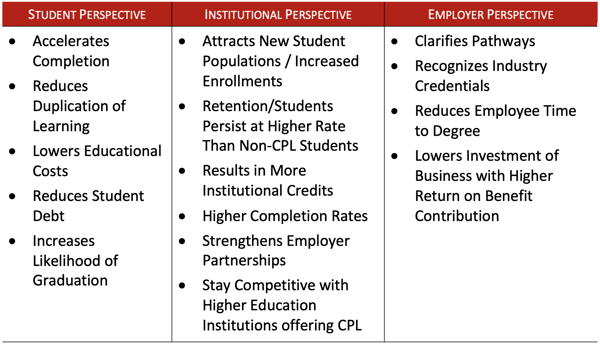Published on
Six Steps to Making Credit for Prior Learning a Reality

With technology advancements, more of today’s jobs require some form of postsecondary education. Thus, higher education is experiencing pressure for improved rates of degree completion from policymakers, accreditors, foundations and businesses. Credit for Prior Learning (CPL) is an innovative approach to address the skills gap by increasing degree completion through recognition of prior college-level learning.
CPL benefits students, colleges and employers. Students who earn CPL credits are more likely to complete a degree or credential and they finish in less time with lower educational costs. A 2010 Council for Adult and Experiential Learning study of more than 60,000 students at 48 institutions found that more than half (56%) of students with CPL credit earned a postsecondary degree within seven years, while only 21% of non-CPL students did so. With CPL, colleges can attract, retain and graduate new student populations, strengthen employer relationships, and remain more competitive in the higher education landscape.
Roadblocks to Delivering Access to CPL
One of the primary roadblocks involves resistance to change. Faculty champions can help by sharing institutional CPL data, highlighting CPL student benefits, framing the challenges and opportunities, listening to concerns, building awareness, and mentoring faculty on institutional processes and procedures. Some faculty will struggle to accept a CPL program, but engaging their participation and developing a model that compensates and incentivizes them for their work makes all the difference.
Limited funding can be another barrier to advancing a CPL program. Administration must identify and allocate resources for CPL infrastructure and services including dedicated personnel to guide learners through the CPL process, technology enhancements, professional development opportunities, faculty incentives for development of crosswalks and assessment instruments, and marketing and public relations strategies.
Developing a CPL policy and procedure is time consuming. It is sometimes a challenge to get faculty, staff and administrators to agree on language. Sharing best practices from peer institutions is helpful.
Six Steps to Creating a CPL-Friendly Environment
1. Research and Planning
The institution begins by researching its current formal and informal practices related to CPL and investigating CPL practices at peer institutions.
2. Administrative Support
Administration, academic leaders and faculty work together to develop a strategic direction.
3. Develop a Business Model
Once a strategic direction is established, a business model is created to identify boundaries, guidelines and best practices around the academic, fiscal, support services and evaluation of the program.
4. Engage Faculty and Staff
Develop an inclusive faculty and staff engagement framework from the beginning. Provide professional development opportunities to bring everyone to a similar understanding of CPL and how it benefits students and the institution.
5. Build CPL Program Infrastructure
Create quality policy, procedure and processes, and establish both fiscal and human resources and services for effective and efficient CPL program operations.
6. Marketing and Public Relations
Creating and maintaining a pool of CPL candidates requires building both internal and external awareness. Formal marketing and promotion need to be supported by informal instructor-student and advisor-student interactions to help identify and secure the CPL program pipeline.
Leveraging the Six Steps to Overcome Obstacles to CPL
Implementing an effective CPL program requires ample time be taken to determine the current state of the institution, research best practices, and most importantly get everyone on the same page to establish commonly agreed upon definitions, guiding principles and standards.
These components are the foundation from which the institution’s policy, procedure and business practices are built. I can’t emphasize the importance of professional development enough, because it is the pathway to faculty and staff engagement.
Not all faculty and staff will be excited to get involved at the outset, so my advice is to get started by expending your efforts on those willing to listen and participate.
It’s important to follow these six steps to allow time for stakeholders to understand and embrace CPL. Involving impacted employees in the process from the beginning helps with overall buy-in and barrier reduction. Faculty compensation and recognition is also critical. Administration will need to work with faculty representation to examine workload assignments and recommend instructor incentives and compensation levels. Finally, creating multiple feedback systems will aid in continuous program improvement.
Successful programs require vision and sustained leadership. CPL has emerged as an important strategy for helping learners finish a degree in less time and with less education debt. Recognizing and communicating the benefits of CPL as a student success strategy helps garner support from administrators, faculty, staff and students.
Author Perspective: Administrator
Author Perspective: Community College



